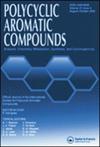In-silico Study of Molecular Docking and Dynamics Simulations for N-Substituted Thiazolidinones Derived from (R)-Carvone Targeting PPAR-γ Protein: Synthesis and Characterization
IF 2.6
3区 化学
Q2 CHEMISTRY, ORGANIC
引用次数: 0
Abstract
In this article, we have selected the monoterpene (R)-carvone combined with thiazolidinone as scaffold. Moreover, this study details the synthesis, characterization, and theoretical analysis of novel (R)-Carvone-thiazolidinone-N-substituted derivatives, sourced from natural (R)-Carvone. The compounds were identified using HRMS, and 1H- and 13C-NMR spectral data. A theoretical analysis provided insights into the stability observed experimentally. The local electronic properties and topological features of two compounds 3 and d were studied using the Multiwfn tool and CrystalExplorer software. Specifically, the electron localization function, localized orbital locator and average local ionization energy were mapped to explore electron distribution, while interaction region indicator was used to analyze intermolecular interactions. An in silico docking study was conducted on the PPAR-γ protein to evaluate the binding affinity and interactions. Furthermore, a 200 ns molecular dynamics simulation was performed to confirm the stability of the compounds within the PPAR-γ protein’s binding site. The results indicated consistent stability for all three compounds under dynamic conditions. Lastly, in silico evaluations of drug-likeness and toxicity prediction showed that all compounds adhere to the criteria of both Lipinski’s Rule of Five and Jorgensen’s Rule of Three, confirming their potential as drug candidates.

(R)-香芹酮衍生的n-取代噻唑烷酮靶向PPAR-γ蛋白的分子对接和动力学模拟的硅研究:合成和表征
本文选择单萜-香芹酮与噻唑烷酮结合作为支架。此外,本研究详细介绍了从天然(R)-香芹酮中提取的新型(R)-香芹酮-噻唑烷酮- n取代衍生物的合成、表征和理论分析。利用HRMS、1H- nmr和13C-NMR谱数据对化合物进行了鉴定。理论分析提供了对实验观察到的稳定性的见解。利用Multiwfn工具和CrystalExplorer软件研究了化合物3和d的局域电子性质和拓扑特征。具体来说,利用电子定位函数、定域轨道定位器和平均局域电离能来探索电子的分布,利用相互作用区域指示器来分析分子间的相互作用。对PPAR-γ蛋白进行了硅对接研究,以评估其结合亲和力和相互作用。此外,还进行了200 ns分子动力学模拟,以确认PPAR-γ蛋白结合位点内化合物的稳定性。结果表明,这三种化合物在动态条件下具有一致的稳定性。最后,药物相似性和毒性预测的计算机评估表明,所有化合物都符合Lipinski的五法则和Jorgensen的三法则的标准,证实了它们作为候选药物的潜力。
本文章由计算机程序翻译,如有差异,请以英文原文为准。
求助全文
约1分钟内获得全文
求助全文
来源期刊

Polycyclic Aromatic Compounds
化学-有机化学
CiteScore
3.70
自引率
20.80%
发文量
412
审稿时长
3 months
期刊介绍:
The purpose of Polycyclic Aromatic Compounds is to provide an international and interdisciplinary forum for all aspects of research related to polycyclic aromatic compounds (PAC). Topics range from fundamental research in chemistry (including synthetic and theoretical chemistry) and physics (including astrophysics), as well as thermodynamics, spectroscopy, analytical methods, and biology to applied studies in environmental science, biochemistry, toxicology, and industry. Polycyclic Aromatic Compounds has an outstanding Editorial Board and offers a rapid and efficient peer review process, as well as a flexible open access policy.
 求助内容:
求助内容: 应助结果提醒方式:
应助结果提醒方式:


